Supplemental restraint system (SRS) - air bag
The information written in this supplemental restraint system (SRS) section contains important points concerning the driver, front passenger, side air bags and pre-tensioner seat belts.
The SRS air bags are designed to supplement the primary protection of the driver and front passenger side seat belt systems by providing those occupants with protection against head and chest injuries in certain moderate-to-severe frontal collisions.
The SRS side air bag is designed to supplement the seat belts and provide the driver and front passenger with protection against chest and abdomen injuries in certain moderate- to-severe side impact collisions.
The SRS is NOT a substitute for the seat belts; for maximum protection in all types of crashes and accidents, seat belts should ALWAYS be worn by everyone who drives or rides in this vehicle. (With infants and small children in child restraints and older children buckled in the rear seat).
WARNING
IT IS VERY IMPORTANT TO ALWAYS PROPERLY WEAR YOUR SEAT BELT, EVEN WITH AN AIR BAG:
(1) Seat belts help keep the driver and front passenger properly positioned
which reduces injury risk in all collisions, and reduces the risk of serious or
fatal injuries when the air bags inflate. During sudden braking just before a collision,
an unrestrained or improperly restrained driver or front passenger can move forward
into direct contact with or within close proximity to the air bag which may then
deploy during the collision. The initial stage of air bag inflation is the most
forceful which could cause serious or fatal injuries if the occupant contacts it
at this stage.
(2) Seat belts reduce the risk of injury in roll-overs, side or
rear impact collisions, and in lower-speed frontal collisions, because driver’s
and passenger’s air bags are not designed to inflate in those situations.
(3)
Seat belts reduce the risk of being thrown from your vehicle in a collision or roll-over.
WARNING
IT IS VERY IMPORTANT TO BE PROPERLY SEATED.
A driver or front passenger too close to the steering wheel or instrument panel during air bag deployment can be killed or seriously injured. Air bags inflate very fast, and with great force.
If the driver and front passenger are not properly seated and restrained, the air bags may not protect you properly, and could cause serious or fatal injuries when it inflates.
(1) Before driving, adjust the driver’s seat as far back as possible while
still maintaining complete control of the vehicle.
(2) Before driving, adjust
the front passenger seat as far back as possible.
(3) Make sure all vehicle occupants
are always properly restrained using the available seat belts.
(4) With seat belts
properly fastened the driver and front passenger should sit well back and upright
without leaning against the window or door.
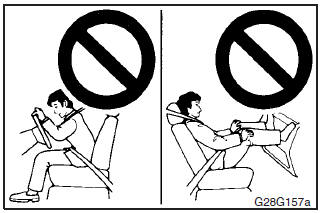
(5) Do not sit on the edge of the seat, or lean head or chest close to
the steering wheel or instrument panel. Do not put feet or legs on or against the
instrument panel.
(6) Place all infants and small children in the rear seat and
properly restrained using an appropriate child restraint system. The rear seat is
the safest for infants and children.
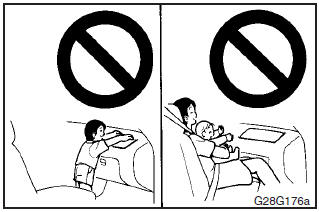
(7) Infants and small children should never be unrestrained, stand up against the instrument panel or held in your arms or on your lap. They could be seriously injured or killed in a collision, including when the air bag inflates. They should be properly seated in the rear seat in an appropriate child restraint system. See the “Child restraint” section on page 3–15.
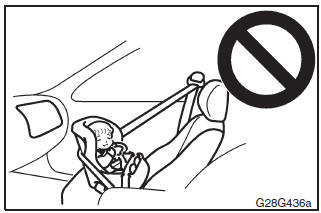
REAR-FACING CHILD RESTRAINTS must NOT be used in the front passenger seat as it places an infant too close to the passenger air bag. The force of an inflating passenger air bag could kill or cause serious injuries to the child.
Rear-facing child restraints must only be used in the rear seat.
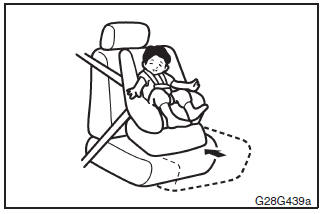
FRONT-FACING CHILD RESTRAINTS should be used in the rear seat whenever possible; if they must be used in the front passenger seat, adjust the seat to the fully backward position. Failure to do so could kill or cause serious injuries to the child.
(8) Older children should be seated in the rear seat, properly wearing the seat belt, with an appropriate booster seat if needed.
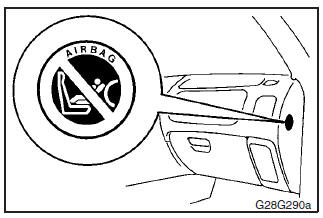
NOTE
The label shown here is attached on vehicles with front passenger air bag. If this label is attached, never install the rearfacing child restraint on the front passenger’s seat.
See also:
Cigarette lighter
The cigarette lighter can be used while the ignition switch is in either “ON”
or “ACC”.
1- Push all the way in.
The lighter will automatically return to its original position with a “c ...
Vehicle care precautions
In order to maintain the value of your vehicle, it is necessary to perform regular
maintenance using the proper procedures.
Always maintain your vehicle in compliance with environmental pollution c ...
Auto Stop & Go (AS&G) system
This paragraph summarizes the major items of the Auto Stop & Go (AS&G) system
such as the characteristics, operating procedures, etc. For details, refer to “Auto
Stop & Go (AS&G) ...
